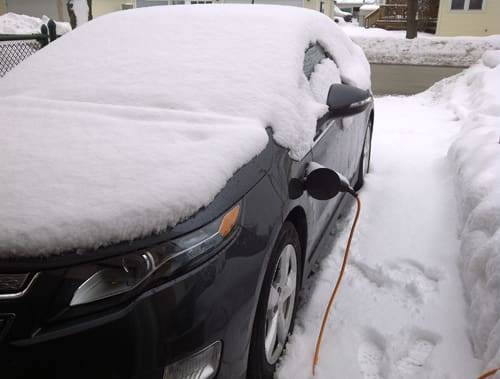Cars.com Chevy Volt: Charging on a Loaded Circuit


My garage circuit is 15 amps and was supporting a few lights, a stereo, the Volt and the heater. I decided to experiment with the Volt’s selectable charge level, designed for exactly this scenario. Once the 120-volt Voltec charger box is plugged into the wall outlet, and before you plug the other end into the car, you can press an orange button that drops the charging from normal level to reduced level. Two of the four LEDs above charger box go dark, indicating that the box will draw 8 amps rather than the usual 12.
I left the lights and stereo on and plugged the charging connector back into the Volt. My space heater has three settings — Low, Medium and High — and uses three heating elements. I knew High was too much, so I went with Medium. After less than a minute, poof. Lights out, stereo off, Volt blaring away, email and text alerts.
I repeated the process again, and this time I turned the heater to Low. Voila! The breaker held. Of course, at this reduced level, charging the battery would take longer. We’ll be investigating how these settings and other issues affect charge time and energy use. We’ve ordered an energy monitor, so geekiness will ensue.
To that end, here’s an obsessive look at what was going on in my garage in amperes (converted from the heater’s wattage ratings and a measured 115 volts):
The Volt was originally drawing 12 amps from a 15-amp circuit. Then I turned on a space heater that draws about 3.5 amps per heating element for a total of 10.4 amps. No wonder the circuit blew.
In the middle range, the heater’s 7 amps plus the Volt’s reduced level of 8 amps also overcame the breaker, likely put over the top by the stereo and lights, which included a 200-watt incandescent bulb as well as a compact fluorescent bulb and two fluorescent shop lights. Once the heater was using 3.5 amps, that left 3.5 amps for the other stuff, and all was well.
Although they don’t typically cause power spikes, electric heaters are exceptionally current hungry, so I wouldn’t expect to get much heat out of a circuit shared with a Volt, but many other electrical devices could share it without problem. It all depends on the current draw. Fuses and breakers can withstand brief spikes as appliances start up, so a small refrigerator or the like could coexist with the Volt so long as the continuous current demand doesn’t exceed what’s available. The experimentation continues.

Former Executive Editor Joe Wiesenfelder, a Cars.com launch veteran, led the car evaluation effort. He owns a 1984 Mercedes 300D and a 2002 Mazda Miata SE.
Featured stories


2026 Aston Martin DBX S Review: Excellence in (DB)X S


